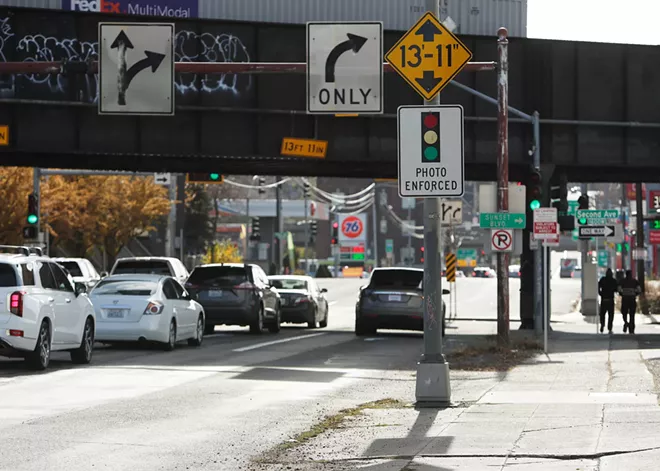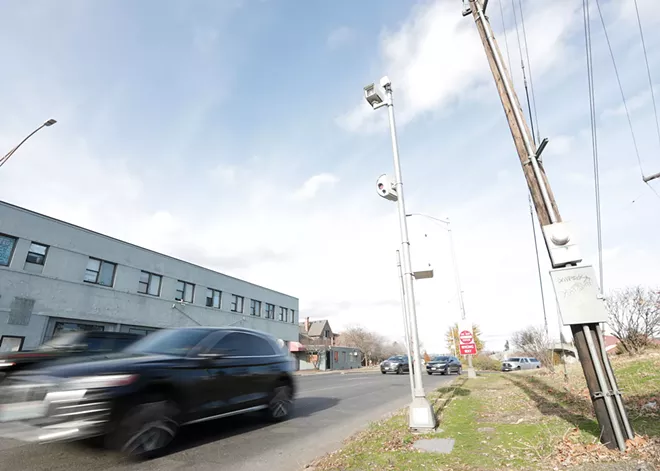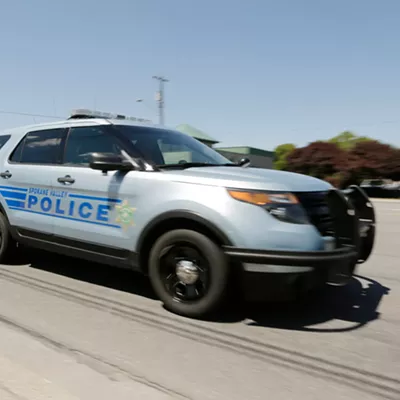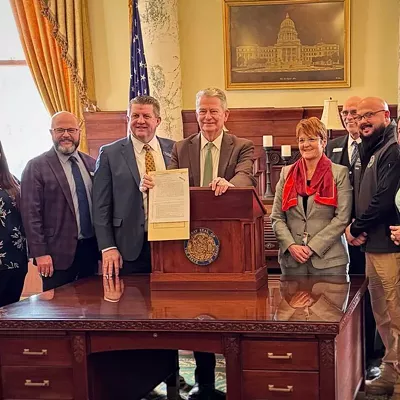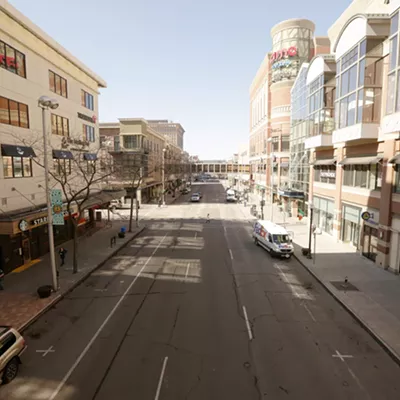In June, Janet Mann was killed in a hit-and-run crash after she stepped into the intersection of Browne Street and Main Avenue in downtown Spokane. The 78-year-old was a foster care director, an author, and a committed cyclist and pedestrian. She had the right of way, but a truck turned right and accidentally hit her. The driver was arrested about a week later.
Mann was the victim of one of seven fatal pedestrian crashes this year in Spokane. The city has seen over 100 total pedestrian-involved collisions in 2024, according to the Washington State Department of Transportation.
After Mann's death, Spokane City Council member Zack Zappone introduced a resolution called "Janet Mann—Safe Streets Now!," which the council passed unanimously on June 24. Then, Mayor Lisa Brown issued an executive order promising to make safe bike and pedestrian infrastructure a top priority for the city.
The same month, a new state law went into effect. House Bill 2384 expanded both the possible locations of traffic safety cameras and the pool of people who are allowed to review infractions.
The intent is to slow traffic by fining more speeders in potentially dangerous areas. But the law also adjusted the penalties, so that people with lower incomes pay only a percentage of the fine, hopefully discouraging speeding without perpetuating economic inequities.
Last week, the City Council passed an ordinance updating Spokane's municipal code for traffic cameras to be in compliance with state law. While updating the code, they also voted 5-2 to turn the Traffic Calming Fund, which doles out revenue from traffic cameras, into the Spokane Safe Streets for All Fund.
The renamed fund goes further than traditional traffic calming. Guided by a national "safe systems" approach researched by the Federal Highway Administration, the city fund can now also pay for pedestrian and bike infrastructure, which will hopefully make streets safer for people like Mann.
"It's a national program that uses a safe systems approach for traffic calming," Zappone says. "There's been a lot of confusion about what qualifies for traffic calming. Some people think it's just slowing down cars. That's why the fund has been used to fund police enforcement significantly over the last couple years. This shift says, 'No, a safe systems approach actually focuses more on road design than enforcement.'"
TRAFFIC CAMERAS
Spokane's eight speed cameras are all located in school zones. They're operational during the hours when students are most likely to be going to and from school. Speed by an elementary school around 9 am and — click! — you'll get a ticket in the mail.Under previous state law, speed cameras were also allowed in public park or hospital speed zones. Under the new law, they're also permitted in roadway work zones and state highways within city limits. That means Spokane could put speed cameras on Division Street, if desired.
The state law also allows for one speed or red light camera per 10,000 people to be placed at any intersection local government deems especially dangerous.
Council member Paul Dillon says there's a desire from some Council members to add more speed cameras over time.
"We hear from neighbors often that they do want more cameras in their neighborhoods," Dillon says. "That has also been very loudly expressed to us, which also, I think, reinforces the need to align with state code."
But per the city budget, new cameras are at the discretion of the police department, which would have to pay to install, maintain and review the cameras. With current budget issues and personnel shortages, it's unlikely that a new fleet of cameras would be operational soon, Dillon says.
SAFE SYSTEMS
Since 2010, the revenue Spokane has collected from traffic safety cameras has gone into the Traffic Calming Fund. The speed cameras, plus 15 red light cameras, usually generate more than $5 million annually. That money is then used to pay for traffic calming measures around the city.Those measures, though, have been vaguely defined. At this time last year, then-Mayor Nadine Woodward clashed with the City Council when she proposed supplementing the police budget with $2.8 million of traffic calming funds to reestablish the traffic unit. The city eventually put $1.8 million from the fund toward the police. The new criteria would make a decision like that harder.
"I think really the purpose of the ordinance is just to safeguard," says Abigail Martin, manager of neighborhood connectivity initiatives for the city. "It puts the burden of proof on the asker for the funds to say, 'I can tie this back to the purposes and delineations of what this fund has been deemed for.'"
Dollars from the fund will still be designated for traditional traffic calming projects, like curb bumpouts, flashing pedestrian lights or striped crosswalks. But money will also be available for projects that make streets friendlier to all modes of transportation.
"The reason that we slow vehicles in these areas is to make them safe for other modes," Council member Kitty Klitzke said in the Oct. 28 briefing meeting. "We use the money for other kinds of safety measures in those areas because we're trying to make these roads safe for everyone, not just drivers."
The first pillar for a safe transportation system, according to the Federal Highway Administration, is that "the safety of all road users is equitably addressed, including those who walk, bike, drive, ride transit, or travel by other modes."
The safe systems approach is baked into the fund's new criteria. Appropriate designations now include any programs that follow the U.S. Department of Transportation "Safe System Approach" or any infrastructure projects with a "demonstrable connection" to safe systems improvements.
All City Council members agree with the desire to safeguard the fund, but not everyone agrees that multimodal systems fit within traffic calming efforts.
"I was the lead person pushing back on funding officers with traffic calming," says Council member Michael Cathcart, who voted against the new ordinance. "I was grateful that others on the council agreed that we needed to 'protect the traffic calming fund' — which they're now willing to unprotect, which is my biggest frustration."
Though Cathcart and fellow Council member Jonathan Bingle both voted nay, it's not because they're against a safe transportation system. Cathcart says he just doesn't believe infrastructure projects like bike lanes have a meaningful impact on slowing traffic.
"Go drive Standard [Street] today, and you will see the concrete barriers that they put up to quote-un-quote 'slow traffic,' and I will tell you you could go 100 miles an hour and not slow a bit," Cathcart says. "That doesn't mean we shouldn't build a bike lane, but it just means we shouldn't use traffic calming money to build a bike lane. That's the crux of the argument."
Cathcart is concerned that the new reductions in fines will decrease the amount of money in the fund while the possible uses for that money increase.
"This is a traffic calming fund, and it should be, you know, calming traffic — not investing in other aspects of transportation," Cathcart says. ♦

